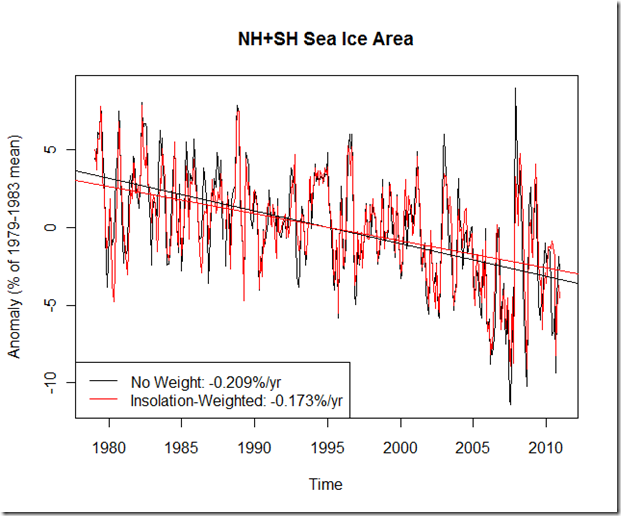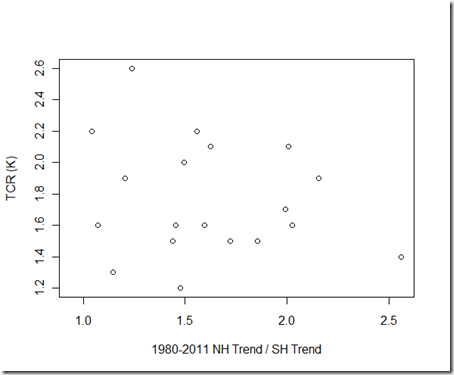I’ve been curious about an insolation-weighted sea ice index for a while now, as this would have the potential to highlight what is most relevant from an albedo-feedback perspective (such as location and time of year of the sea ice area). In fact, my primary interest was what this would reveal with respect to the importance of Northern vs. Southern hemisphere sea ice trends. Recently, Dr. Pielke even pointed to a paper of his doing an insolation-weighted analysis, although I would also like to include a combined NH+SH global index as well.
Anyhow, having never worked with the NCIDC sea ice data before, Jeff Id’s code was helpful in greatly reducing the learning curve. I decided only to use monthly data (rather than daily) from NSIDC, which you can get from here (you may need to register first). Code and the other data is available here, although you’ll need to download the North and South ice area files first from the location I have given and put them into respective folders "North" and "South" within the working directory specified atop the script.
My method is fairly simple: determine the average TOA insolation for each latitude band (1 degree width) each month (Jan, Feb, etc.) from the four year average (2001-2004) according to CERES SSF1 degree dataset (which I believe in turn gets its incident solar radiation from SORCE). Since we have the latitude for each sea ice area grid point, we can multiply that area fraction by the solar insolation at that latitude for the month. In terms of quality control, I have done very little (although I’m using the "final" rather than "preliminary" NSIDC dataset). First, due to the transition from n07 to f08, the different satellite trajectories led to fewer orbit-induced missing points above the Arctic (from 1799 to 468), so these these points must be kept masked throughout the entire period to avoid a spurious jump. Second, there is a "major data gap in the SSM/I data" for the SH, leaving only 2 days in December 1987 and creating an obvious outlier, so I’ve excluded that single month. Other than that it’s pretty straightforward in this first pass.
Obviously, to compare the insolation-weighted metric to the raw values on the same graph we’ll want to use the percent change anomaly. Anyhow, here are the results:

So what is interesting at this juncture? Well, the insolation-weighted metric slightly increases the decline rate in the NH relative to the raw values, while slightly decreasing the incline rate in the SH. At first thought, this would seem to imply that the combined NH+SH insolation-weighted metric would show a steeper decline than the raw metric. However, this is not the case – presumably because the bulk of the sea ice in the SH is further from the pole than NH sea ice, and therefore receives more insolation. This result is at least qualitatively consistent with Hall (2004) , where sea ice is expected to play a larger role in the SH.
That said, I consider this a first pass because it does not take into account clouds, uses TOA solar insolation rather than surface and uses a single monthly average (not broken up by time of day) for insolation, all of which may be an oversimplification. There are methods that I’m pursuing which may better translate directly into the effect of sea ice changes on global albedo.





